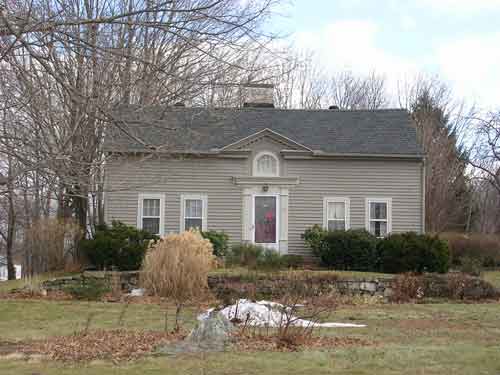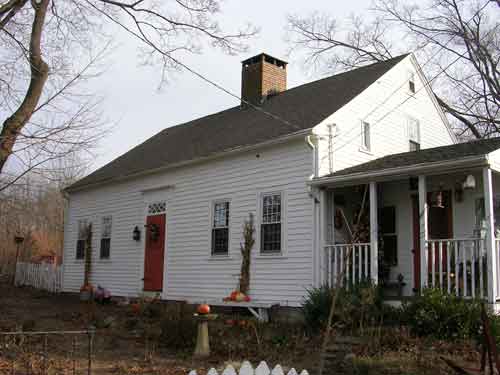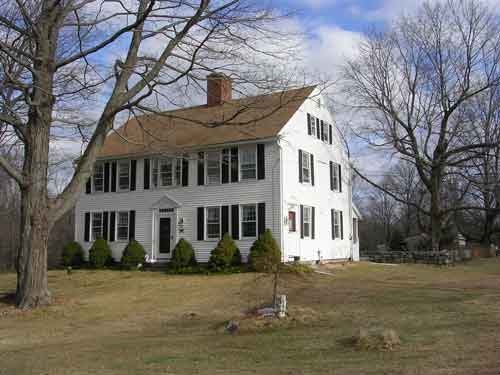|
|
||||||||||||
 |
 |
|
Wolcott Historical Society News - March 2009 By Florence Goodman In this edition I will discuss the history of the last three historical houses found encompassing our Town Green and historic district. They are the Darius Wiard, the David Harrison, and the Bishop-Woodward houses. Next month, I will conclude this series with the last two historic structures found on or around the Town Green: the Congregational Church and the Wolcott Grange. The Darius Wiard House is located at 1 Farmingbury Road, east of the Town Hall. This 1-1/2-story, Georgian-style post-and-beam frame house with a large central chimney was built in 1797 for Darius Wiard. He lived in the house until 1803. From 1803 through 1887, occupants of the house included the Rowe, Potter, Nichols, and Alcott families. From 1887 through the early 1970s, the Bronson family owned and occupied the house. Around 1900, they added the barn to the property. Ransom Bronson, the last in the lines of Bronsons, lived in the house until 1970. The DeMarchena family presently owns the house. The front doorway of the house is unusual because of the pediment above the doorway, which contains a decoratively paned semicircular arch window that is rarely found in a cape. This house is architecturally significant as the best-preserved example of a Georgian-style residential frame house surviving in the town. The David Harrison House, also known as the Peggy Brown Place, is located at 228 Center Street. Land records indicate that this 1-1/2-story post-and-beam Colonial/Federal cape with a large central chimney was built around 1777. This house is architecturally significant as one of the best remaining examples of a Revolutionary era frame house surviving in the town of Wolcott. Land records indicate that in 1776 David Harrison purchased the land from Daniel Tuttle. In 1789, Harrison sold the house and property to Elizur Andrews. Late in the 18th century, this house saw numerous owners. They included Aaron Harrison, Chloe Dutton, Moses Todd, Philo Thomas, Adonijah Moulthrop, Lyman Tuttle, Bnai Bishop, Hezekiah Todd, William Robinson, and Asaph Hotchkiss. In 1801, Hotchkiss sold the house to Abagail Pardee, who in turn sold it to Pitman Stowe around 1807. Mr. Stowe operated an inn on the premises until 1815 when it was sold to Reverend John Keys, who, at that time was pastor of the Congregational Church. Later, Peggy Brown owned the house and it was referred to as her place. It served as a Post Office when William Brown was Wolcott’s postmaster. Helen Bishop also owned the house. Today Curt and Barbara Wood own the house. The Bishop-Woodward House, a large 2-1/2-story Federal period Colonial style house was built in 1790 for Bnai Bishop. It is located just east of the Congregational Church on 205 Center Street. Orcutt wrote, "in 1799 Reverend Israel Woodward purchased a certain piece of land, together with a large dwelling with a store and horse shed adjoining the same from Bnai Bishop." This large, stately home contains five fireplaces, plus other amenities, which indicate that it was used for something other than just a farmhouse. Some of the unusual features found in the house are a front door that has wood strips running vertically on the outside and horizontally on the inside, supposedly to keep arrows from penetrating the door. The door on the roadside is extra wide and called a funeral door because it allowed caskets to be easily carried through it. One of the upstairs bedrooms has beautifully carved diamond and rope shape wood molding. It is believed that sailors who spent a winter in the house did the carvings. While Mr. Bishop owned the house it served as a hostelry catering to travelers on foot, horse or stagecoach. A passageway in the rear of the house leading to stables also substantiates that it was used an inn. Mr. Bishop also ran an adjoining store. During Reverend Woodward's ownership, the home was used as a school for local men studying in preparation for the ministry at colleges such as Yale and Harvard. The students, numbering from six to eight lived with the Ministers family. The Reverend Woodward's family lived in the house until his death in 1810. Around 1900, Mr. Adelbert Woods, Wolcott's last postmaster, had his headquarters in this house. Later, Richard Opper purchased the house and lived there until the late 1980's when it was turned over to Bud and Mary Rogers. They later sold it to their daughter. Today, K. Dumouchel owns the home. It is obvious that Wolcott’s town center continues to maintain its historic character and charm. (Much of the information for this article was taken from the "National Register of Historic Places Registration form," completed in 2000, Wolcott, Connecticut 175th Anniversary booklet 1796-1971 by John Washburne, and The 1986 Historic Resources Inventory by J.P. Loether.) Old Time Wolcott News Articles Recently, Mr. George Maher of Woodtick Road donated some old newspapers dating back to the late 1800s to the Society. The paper was called The New England Homestead and was printed monthly in Springfield, Massachusetts. It sold for $2 per year. The newspaper contained many articles concerning agricultural information and ads. There is a section for news from towns within each New England state. Those related to Wolcott will appear on our Web site in the future. Attention High School Seniors!!! Visit our website for details concerning the Wolcott Historical Society's scholarship application offered to Wolcott graduating seniors. Attention Gardeners: The Wolcott Historical Society will be hosting a Garden Tour in early July and are looking for gardens. If you would like to participate we would love to show your garden. Please contact Flo Goodman 879-9818.
Darius Wiard House
David Harrison House
Bishop Woodward House To view past installments of the Wolcott Historical Society News, click here. |
|
|
[Home]
[News]
[Purpose]
[Calendar]
[Museum]
[Membership]
[History]
[Contacts]
[Links]
All material at Wolcott Historical Society Web sites Copyright © 2000-2010 Wolcott Historical Society |


